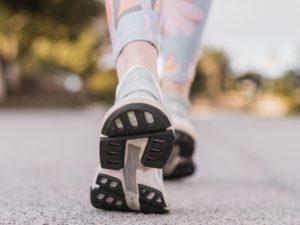5 Amazing Tips To Fix The Most Common Fitness Mistakes
Fitness is about progress, not perfection. This means we all make fitness mistakes at one point or another, and with fitness, there’s plenty of common fitness mistakes to make.

Fitness is a journey that gets a little rocky sometimes. Here are 5 common fitness mistakes you might be making and what to do instead.
5 Most Common Fitness Mistakes
Here are the 5 most common fitness mistakes everyone has made!
Many of these mistakes won’t hurt you necessarily, but they won’t help you get the results you want.
1. Trying to Spot Reduce Fat with Exercise
We can grow muscle in areas we train, so the same must apply to body fat, right? While this makes sense, spot-reducing fat is not possible scientifically. We lose body fat throughout the body with proper exercise and diet.
Any workout that claims to reduce arm fat or stomach fat is just clickbait and a false advertisement.
What to do instead:
You cannot spot reduce fat but you can spot training muscles. At rest, muscles require more energy to maintain so work on building muscles to increase fat reduction throughout the body. Big muscle groups, like the legs or back, are a great area to target, as these areas are composed of many large muscles.
Think of a squat! Doing one requires the quads, calves, glutes, and core.
2. Working out Everyday
While working out every day may seem like a great thing, it can cause burnout rapidly. You may try to make up months of not working out in a short amount of time but this may cause you to feel overwhelmed and unmotivated.
Furthermore, pushing yourself too far too soon is likely to lead to injury. Overtraining is one of the reasons people get hurt, burn out, and lose motivation.
What to do instead:
Workout out 2 to 3 times a week, or every other day, then gradually increase to 4 to 5 times a week, at most 6. Rest days are just as important as intense workout days and you can still move your body when resting!
Try a relaxing yoga routine or some classic stretch poses to reduce tightness in the body. You can even do less intense exercise like going on a walk or riding a bike.
3. Not Warming Up or Cooling Down
Any type of training without a proper warm-up increases your risk for injury. Warming up will prepare the body for activity, raising heart rate, temperature, and blood flow to the muscles. This will help you perform better, and prevent soreness and injury.
Cooling down is vital if you want to prevent too much soreness in the muscles. Cooling down allows the body to go back to rest, allows your heart rate to slow, and prevents any dizziness or fainting.
What to do instead:
Warm-up and cool down!
Warming up can be very simple, doing some jumping jacks, going on a brisk walk, lunges, or squats. Get some movement in to prepare muscles, like overhead arm reaching, leg swings, and shoulder shrugs.
Cooling down is just as simple. Stretch the body with shoulder rolls, toe touches, and arm reaches. Walk in place and allow the body to return to normal baseline.
If you are running, warm up by stretching and walking, and for your cool down, slow your pace until you are walking, allowing the heart rate to lower.
4. Losing Weight too Quickly
Losing weight too quickly is a surefire way to gain all the weight back, if not more. Losing weight too quickly can lead to fatigue, headaches, muscle loss, drastic reduction in metabolism, and eventually going into starvation mode. You see, the body wants to keep you alive, so if it receives the signal that there is little food and intense activity, it will try to slow its metabolism to conserve energy, and even draw energy from muscles.
You may also become deficient in important nutrients with a caloric deficit that causes extreme weight loss.
What to do instead:
Go on a minor calorie deficit while attempting to keep up workout activity. This will help the body gradually adjust to a lower body weight without drastically reducing metabolism. Continue to train muscle tone to prevent muscle loss as you go as well.
Plus, try not to focus on the scale, as this can lead to body dysmorphia, low self-esteem, and unnecessary stress and worry. The scale does not determine worth, nor is it a good way to note how much body fat you lose or muscle you gain.
5. Buying Expensive Equipment
You might not go to the gym so want an at-home experience. Which is fine, helpful even. Fitness equipment can be useful, weights, yoga mats, pull-up bars, and resistance bands.
Truly though, all you need is your body weight and the floor. Buying too much, then not really using any of it can feel unmotivating and irritating.
What to do instead:
Start with a good bodyweight workout. This is entirely free and simple to incorporate into your daily life. You can train every part of the body with calisthenics, body weight exercises.
The best part is any workout can be made easier or harder. For example for push-ups, you can work up to floor push-ups by starting on wall push-ups. Just stand arm’s length away from the wall and do a push-up there. To make a push-up harder, train up to one-handed push-ups, or jumping push-ups.
Any bodyweight exercise can be made easier or harder, which makes it a great way to increase fitness, for free.
Quick Troubleshooting of Common Fitness Mistakes
Here are some common issues anyone can run into in fitness and how to fix them!
Plateau in Weight Loss
This may be for many reasons, but the most common is habituation. The body may become used to the diet and exercise, which means it’s time to switch things up!
Weight Gain
As stated before, the scale is not an accurate representation of fitness. Weight gain may just be muscle gain! So use the scale as a guide but do not let it get you down. Instead, use a tape measure to see if you are losing belly fat or use it to track if your muscles are bigger.
No Time to Workout
Maybe you no longer have time to work out. No problem! Studies have found that s 20-minute routine of HIIT, high-intensity interval training, can be just as effective as a 40-minute workout routine.
Fit in fitness where and when you can.
Sore Muscles
Sore muscles can make even walking painful. The solution is recovery. Rest, rest, rest.
Don’t think of recovery days as unproductive. The body does some of its best muscle building on rest days. Plus, good recovery days mean you have more energy to train the next day.
Check out this complete guide to post-workout recovery here!
The Takeaway
Fitness is about progress, not perfection, but we can always fix any mistakes we make and reduce issues.
While you can’t spot reduce fat, you can spot train muscles, which is more helpful to long-term fitness. Warming up and cooling down, even a short 5-minute warm up and cool down, is the best way to prevent injury.
Remember to fuel the body right and recover when needed. Diets don’t work; instead, form healthy eating habits you want to do.
You don’t need fancy equipment or a gym to work out and be fit, you can use your body, and fit in exercise when you can!





